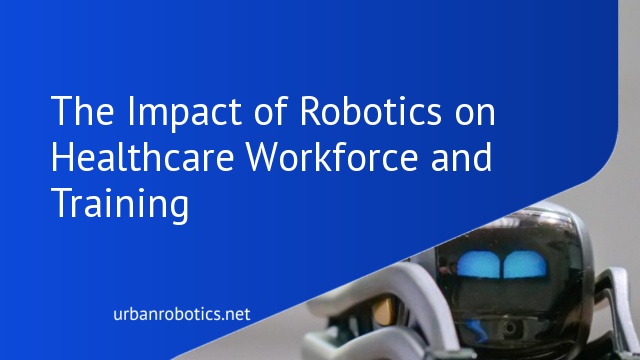In today’s rapidly evolving healthcare landscape, robotics has emerged as a game-changer, revolutionizing the way we deliver care and support patients. The integration of robotics in healthcare not only enhances the efficiency and precision of medical procedures but also significantly impacts the healthcare workforce and training. From surgical-assistance robots to autonomous mobile delivery robots, robots are taking on various roles in healthcare facilities, transforming the way we work.
The global market for medical robots is projected to reach a staggering $12.7 billion by 2025, with hospitals leading the way in adopting this groundbreaking technology. With advancements like the da Vinci Surgical System and the TUG autonomous mobile delivery robot, robots are now capable of performing complex surgeries, interacting with patients, disinfecting rooms, and even conducting data mining.
By incorporating robotics into healthcare, we can free up valuable time for healthcare professionals, allowing them to focus on critical tasks and personalized treatments. The potential for robots to perform lab tests, remove artery plaque, and deliver targeted medication holds immense promise for the future of healthcare.
However, as with any technological advancement, there are challenges to navigate. Building patient trust in robot-assisted procedures, addressing the shortage of skilled professionals in robotics, and ensuring the safety of robotic systems are some of the hurdles we must overcome. By promoting education and training in robotics and establishing protocols for safety and cybersecurity, we can pave the way for a future where robots seamlessly enhance patient outcomes and streamline healthcare delivery.
The future of robotics in healthcare is bright, but it requires collaboration between medical practitioners and robotics companies to develop advanced systems that improve patient care and keep pace with the ever-changing landscape of healthcare.
Advancements in Robotic Technology
Robotic technology has made significant advancements in the healthcare sector. These advancements have revolutionized medical procedures and improved patient outcomes. One notable example is the da Vinci Surgical System, which features a magnified 3D high-definition vision system and highly precise instruments that can bend and rotate beyond the capabilities of the human hand. This robotic system has been widely used in surgeries such as cancer tissue removal, coronary artery bypass, hysterectomy, and kidney transplant. Its advanced capabilities have made procedures more precise and efficient, leading to increased surgery success rates.
Another groundbreaking invention is the TUG autonomous mobile delivery robot. This robot is capable of carrying heavy loads and completing thousands of deliveries each week in hospitals across the United States. It plays a crucial role in streamlining the delivery process, ensuring that medical supplies and equipment reach their destinations quickly and efficiently. These advancements in robotic technology have paved the way for more precise and efficient care in healthcare facilities.
Other Pioneering Robotic Inventions
In addition to the da Vinci Surgical System and the TUG autonomous mobile delivery robot, there are various other pioneering robotic inventions in the healthcare field. These include social companion robots, medication management systems, disinfecting robots, and capsule robots. Social companion robots provide companionship and support to patients, particularly those who may be isolated or in need of emotional assistance. Medication management systems help ensure that patients adhere to their medication schedules, offering reminders and dispensing the correct doses. Disinfecting robots play a crucial role in maintaining cleanliness and preventing the spread of infections in healthcare facilities. Capsule robots are used for diagnostic purposes, allowing healthcare professionals to capture images and collect samples from various parts of the body. These advancements in robotic technology have transformed the way healthcare is delivered and have the potential to further revolutionize the industry in the future.
Use Cases for Robotics in Healthcare
Robotics has revolutionized the healthcare industry, offering numerous use cases that improve patient outcomes and enhance the efficiency of medical procedures. One notable use case is the use of robotic assistance in performing brain stimulation surgery. In a groundbreaking procedure in China, doctors used robotic assistance and a 5G connection to perform a brain stimulation surgery on a Parkinson’s patient located nearly 1,900 miles away. This innovative approach enabled remote surgery and expanded access to specialized care for patients in remote areas.
Another significant use case of robotics in healthcare is the deployment of microbots for disease detection and treatment. These tiny robots are able to capture images of the digestive tract, aiding doctors in diagnosing and treating diseases with greater precision. By providing a detailed view of the internal organs, microbots contribute to early detection and targeted treatment, leading to improved patient outcomes.
In addition, robotics has transformed minimally invasive surgery by enabling smaller incisions and reducing the risk of complications and infections. Surgeries and procedures that benefit from robotic assistance include tumor removal, hip replacements, and gallbladder removal. The integration of robotics in these procedures enhances precision, reduces patient trauma, and shortens recovery time.
Robotics Use Cases Summary:
- Robotic assistance in remote surgeries, expanding access to specialized care
- Microbots for disease detection and targeted treatment
- Enhanced precision and reduced risk in minimally invasive surgeries
| Use Cases for Robotics in Healthcare | Benefits |
|---|---|
| Remote surgeries with robotic assistance | Expanded access to specialized care |
| Microbots for disease detection and treatment | Precise imaging and targeted treatment |
| Minimally invasive surgeries with robotic assistance | Enhanced precision and reduced risk |
Benefits and Challenges of Robotics in Healthcare
The implementation of robotics in the healthcare environment offers several benefits. One of the key advantages is the automation of monotonous and administrative tasks, allowing healthcare professionals to focus on more critical responsibilities. By delegating repetitive tasks to robots, we can free up workers’ time and improve overall efficiency in healthcare settings. Additionally, robotics can lead to a reduction in the duration of surgeries, creating personalized treatments, and increasing the success rates of procedures. Robots provide enhanced ergonomics and comfort for surgeons, enabling them to perform procedures with greater precision and less fatigue.
However, the widespread adoption of robotics in healthcare also faces several challenges. One major hurdle is the lack of patient trust in robot-assisted procedures. It is crucial for healthcare practitioners to effectively communicate the benefits and safety of using robotics in medical treatments to gain patient confidence. Another challenge is the shortage of skilled professionals in robotics and related fields. Healthcare organizations need to invest in education and training programs to bridge this skill gap and ensure a competent workforce for the future. Additionally, safety risks associated with the use of robots in healthcare settings must be addressed to prevent accidents and ensure patient well-being. Robotic systems should have robust safety protocols and cybersecurity measures to mitigate these risks.
Benefits of Robotics in Healthcare:
- Automation of monotonous and administrative tasks
- Reduction in the duration of surgeries
- Creation of personalized treatments
- Increased success rates of procedures
- Enhanced ergonomics and comfort for surgeons
Challenges of Robotics in Healthcare:
- Lack of patient trust in robot-assisted procedures
- Shortage of skilled professionals in robotics and related fields
- Safety risks associated with the use of robots in healthcare settings
| Benefits | Challenges |
|---|---|
| Automation of monotonous and administrative tasks | Lack of patient trust in robot-assisted procedures |
| Reduction in the duration of surgeries | Shortage of skilled professionals in robotics and related fields |
| Creation of personalized treatments | Safety risks associated with the use of robots in healthcare settings |
| Increased success rates of procedures | |
| Enhanced ergonomics and comfort for surgeons |
In conclusion, the integration of robotics in healthcare brings about various benefits, including increased efficiency, improved surgical outcomes, and enhanced working conditions for healthcare professionals. However, it is essential to address the challenges of patient trust, skill shortage, and safety risks associated with the use of robots. By effectively communicating the advantages of robotic technology, investing in education and training, and implementing robust safety protocols, we can fully leverage the potential of robotics in healthcare and drive positive advancements in patient care.
The Impact of Robotics on Employment and Motivation in Healthcare
The integration of robotics in healthcare has had a significant impact on employment and motivation within the industry. While there are concerns about job displacement and the loss of human interaction, evidence suggests that the introduction of robots can actually create new job opportunities and enhance workforce motivation. By automating monotonous and repetitive tasks, robots free up healthcare professionals to focus on more complex and critical responsibilities. This not only improves the efficiency of healthcare delivery but also allows for a greater emphasis on patient care and personalized treatment plans.
Robots in healthcare settings can serve as valuable assistants to healthcare professionals, supporting them in their day-to-day work. They can perform tasks such as collecting and analyzing patient data, assisting in surgical procedures, and providing routine care to patients. This collaboration between humans and robots not only increases the productivity of healthcare teams but also contributes to a positive and motivated work environment. Healthcare professionals can rely on robots to handle repetitive tasks, allowing them to devote more time and energy to patient care, decision-making, and delivering high-quality treatments.
However, it is important to address the concerns and challenges associated with the introduction of robotics in healthcare. The fear of job displacement and the potential loss of human interaction must be acknowledged and managed effectively. Organizations should prioritize the employment and motivation of their workforce, ensuring that the integration of robots complements and enhances the skills and capabilities of human workers. This can be achieved through training programs that equip healthcare professionals with the necessary skills to work alongside robots and by fostering a culture of collaboration and teamwork.
Overall, the impact of robotics on employment and motivation in healthcare is a complex issue that requires careful consideration. While robots can automate certain tasks and improve efficiency, it is essential to strike a balance between the use of robotics and the need for human interaction and care. By embracing robotics as valuable tools and empowering healthcare professionals to work alongside them, we can create a future where robots and humans collaborate to provide the best possible healthcare outcomes.
| Benefits of Robotics in Healthcare Employment | Challenges of Robotics in Healthcare Employment |
|---|---|
|
|
The Future of Robotics in Healthcare
The future of robotics in healthcare holds immense potential for transforming the way we deliver medical care. Advancements in robotics technology are paving the way for exciting possibilities that could revolutionize the field in the coming years.
One area of development is the use of robots to perform lab tests, a task that traditionally requires human involvement. With the ability to accurately analyze samples and generate results, robots could significantly speed up the diagnostic process, leading to faster treatment decisions and improved patient outcomes.
Another exciting prospect is the use of robots to remove artery plaque. Plaque buildup in arteries can lead to serious health issues, such as heart disease and stroke. By utilizing robots with precision instruments, we can potentially remove arterial plaque more effectively, reducing the risk of these life-threatening conditions.
In addition, robots may become instrumental in the delivery of targeted medication. By programming robots to navigate through the body and target specific areas, we can enhance the effectiveness of drug delivery and minimize side effects by precisely delivering medication to the intended site.





